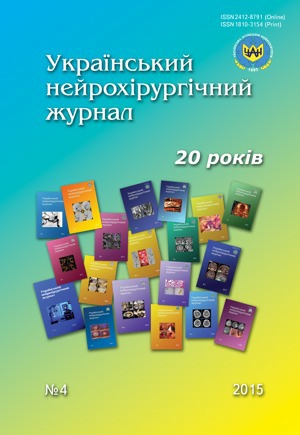Results of selective dorsal rhizotomy in the treatment of local spasticity of lower limb extremities
DOI:
https://doi.org/10.25305/unj.55958Keywords:
selective dorsal rhizotomy, local spasticity, muscle toneAbstract
Aim: To develop diagnostic methods and to improve procedure of the dorsal selective rhizotomy (DSR) in patients with the local spasticity of lower extremities.
Materials and methods: DSR (L2-S1) were performed in 12 patients with incurable local spasticity of lower limbs: 6 cases with infantile cerebral palsy (ICP), 6 cases with consequences of myelitis on the thoracic level and consequences of spinal injury. Muscle tone in different muscles was in range 3,8-4,0 (Ashworth scale), muscle strength – 2,2-2,6 (ASIA scale), range of passive motion was limited to 3-4 level. Degree of motor inability was assessed by Gross Motor Function Classification System (GMFSC). Bupivacaine 1,0% blockage was performed to reveal contractions. Plastic laminotomy was performed in patients with ICP. Catamnesis was 4 years.
Results: Significant decrease of muscle tone was explored in all patients to 1,2-1,6 points (p<0,05), range of motion was elevated (p<0,001), increasing of muscle strength was statistically not reliable. We observed GMFSC motor function improvement in 8 patients (1 category) and decreasing of muscle tone up to 1,5-2,3 points (excellent result), in 2 patients we observed decrease of muscle tone up to 1-1,5 points without any change in locomotive status (good result). In 2 patients muscle tone decreased up to 1 point without any changes according to GMFCS (satisfying result). Recurrence of spasticity, vertebral deformities, sensation disturbances were not revealed.
Conclusions: Lumbar DSR is an effective method of treatment of local incurable spasticity in lower limb extremities. It ensures long-term decrease of muscle tone, increase of functional abilities and improves patients care.
Bupivacaine nerve blockage probe on the pre-op stage reveals irreversible changes in muscles and joints.
DSR is contraindicated in the mixed forms of muscle tone disturbances (rigidity, dystonia) in cases where spasticity was used for the gait.
Plastic laminotomy in children avoids spine column deformity in the long-term period.
DSR has to be performed with the usage of microsurgical instrumentation, microscope and intra-op monitoring.
References
1. Matviyenko YuO. Spastychnist: ohlyad problemy [Spasticity: Overview of the problem]. Sudynni zakhvoryuvannya holovnoho mozku. 2014;2-3:29-34. Ukrainian.
2. Gracies J.-M. Pathophysiology of spastic paresis. I: Paresis and soft tissue changes. Muscle Nerve. 2005;31(5):535-551. [CrossRef] [PubMed]
3. Ekusheva EV, Shavlovskaya OA. [A role of the level of the nervous system lesion in the development of spasticity]. Zh Nevrol Psikhiatr Im S S Korsakova. 2013;113(4):54-6. Russian. [PubMed]
4. Russman B, Ashwal S. Evaluation of the child with cerebral palsy. Semin Pediatr Neurol. 2004;11(1):47-57. [CrossRef] [PubMed]
5. Duncan PW, Zorowitz R, Bates B, Choi JY, Glasberg JJ, Graham GD, Katz RC, Lamberty K, Reker D. Management of adult stroke rehabilitation care: a clinical practice guideline. Stroke. 2005;36:e100-e143. [CrossRef] [PubMed]
6. Khat'kova SE. [Current trends in the use of botulinum treatment(dysport)in post-stroke spasticity]. Russian Zh Nevrol Psikhiatr Im S S Korsakova. 2012;112(8):92-9. Russian. [PubMed]
7. Shabalov VA, Dekopov AV, Tomskiĭ AA, Salova EM. [Posterior selective rhizotomy in the treatment of severe spastic syndrome in cerebral palsy]. Zh Vopr Neirokhir Im N N Burdenko. 2010 Apr-Jun;(2):14-8. Russian. [PubMed]
8. Belova AN. [Scale, tests and questionnaires in neurology and neurosurgery]. Moscow; 2004. 432 p. Russian.
9. Palisano R, Rosenbaum P, Walter S, Russell D, Wood E, Galuppi B. Development and reliability of a system to classify gross motor function in children with cerebral palsy. Development Med Child Neurol. 1997;39(4):214-23. [CrossRef] [PubMed]
10. Vlasenko SV, Kushnir GM. [Catamnesis Results of Botulinum Toxin Type A Application in Patients with Cerebral Palsy with Spastic Diplegia Form within 10-year Observation Period]. Mezhdunarodnyy nevrologicheskiy zhurnal. 2011;2(40):129-36. Russian. [eLIBRARY.ru]
11. Nenko AM, Deryabin AV. Original'nyye metody khirurgicheskogo lecheniya detey s tserebral'nym paralichom, razrabotannyye v spetsializirovannom klinicheskom sanatorii. [Original methods of surgical treatment of children with cerebral palsy developed in a specialized clinical sanatorium]. Vestnik fizioterapii i kurortologii. 2007;(2):54-56. Russian.
12. Umnov VV, Kenis VM. Ortopedo-neyrokhirurgicheskaya kontseptsiya kompleksnogo lecheniya detey so spasticheskimi paralichami. [Orthopedic and neurosurgical concept of integrated treatment of children with spastic paralysis]. Vestnik travmatologii i ortopedii im NN Priorova. 2007;4:9-14. Russian.
13. Schekolova NB, Belokrylov NM, Nenahova YV. Ortopedicheskiye aspekty korrektsii dvigatel'nykh narusheniy u detey s tserebral'nym paralichom. [Orthopedic aspects of correction of motor disorders in children with cerebral palsy]. Rossiyskiye meditsinskiye vesti. 2009;14(2):14-22. Russian.
Downloads
Published
How to Cite
Issue
Section
License
Copyright (c) 2015 Leonid Pichkur, Iuriy Iaminskiy, Yuriy Lontkovsky

This work is licensed under a Creative Commons Attribution 4.0 International License.
Ukrainian Neurosurgical Journal abides by the CREATIVE COMMONS copyright rights and permissions for open access journals.
Authors, who are published in this Journal, agree to the following conditions:
1. The authors reserve the right to authorship of the work and pass the first publication right of this work to the Journal under the terms of Creative Commons Attribution License, which allows others to freely distribute the published research with the obligatory reference to the authors of the original work and the first publication of the work in this Journal.
2. The authors have the right to conclude separate supplement agreements that relate to non-exclusive work distribution in the form of which it has been published by the Journal (for example, to upload the work to the online storage of the Journal or publish it as part of a monograph), provided that the reference to the first publication of the work in this Journal is included.









